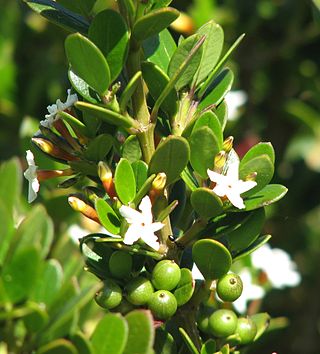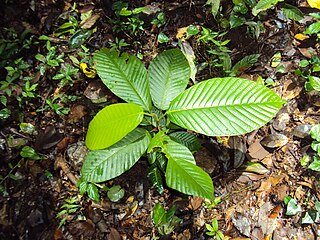
Alyxia is an Australasian genus of flowering plant in the dogbane family, Apocynaceae. It contains at present 106 species, but Alyxia stellata and A. tisserantii are very variable, might be cryptic species complexes, and are need of further study. It consists of shrubby, climbing or scrambling plants. This genus occurs in China, the Himalayas, Southeast Asia, Australia, New Caledonia and the Pacific Islands. There are 14 species in Australia, 21 in New Caledonia and 7 in the other Pacific Islands, including Hawaiʻi.

Antidesma is a genus of tropical plant in the family Phyllanthaceae formally described by Linnaeus in 1753. It is native to tropical Africa, S + E + SE Asia, Australia, and various oceanic islands. The greatest diversity occurs in Southeast Asia.

Canarium is a genus of about 120 species of tropical and subtropical trees, in the family Burseraceae. They grow naturally across tropical Africa, south and southeast Asia, Indochina, Malesia, Australia and western Pacific Islands; including from southern Nigeria east to Madagascar, Mauritius, Sri Lanka and India; from Burma, Malaysia and Thailand through the Malay Peninsula and Vietnam to south China, Taiwan and the Philippines; through Borneo, Indonesia, Timor and New Guinea, through to the Solomon Islands, Vanuatu, New Caledonia, Fiji, Samoa, Tonga and Palau.

Plocoglottis is a genus of orchids, native to Southeast Asia and to various islands from the Andaman Islands to the Solomons.

Dipterocarpus is a genus of flowering plants and the type genus of family Dipterocarpaceae.

Daemonorops was a genus of rattan palms in the family Arecaceae. Its species are now included within the genus Calamus. Species now placed in Daemonorops are dioecious, with male and female flowers on separate individuals. They are found primarily in the tropics and subtropics of southeastern Asia with a few species extending into southern China and the Himalayas.

Chionanthus, common name: fringetrees, is a genus of about 140 species of flowering plants in the family Oleaceae.

Actinodaphne is an Asian genus of flowering plants in the laurel family (Lauraceae). It contains approximately 125 species of dioecious evergreen trees and shrubs.

Barringtonia is a genus of flowering plants in the family Lecythidaceae first described as a genus with this name in 1775. It is native to Africa, southern Asia, Australia, and various islands of the Pacific and Indian Oceans. The genus name commemorates Daines Barrington.

Alseodaphne is a genus of plants in the family Lauraceae, endemic to China and Southeast Asia. The genus has 96 species of evergreen trees to shrubs. They have bisexual flowers, a fruit stalk that is red, green, or yellow, and black fruit.

Anodendron is a genus of plant in the family Apocynaceae first described as a genus in 1844. It is native to most of tropical Asia: China, the Indian subcontinent, Southeast Asia, New Guinea, and some islands of the western Pacific.

Thelasis, commonly known as fly orchids, is a genus of flowering plants from the orchid family, Orchidaceae. Plants in this genus are usually epiphytes, sometimes lithophytes or rarely terrestrials. Some species have pseudobulbs with up to three leaves, whilst others have several leaves in two ranks. A large number of small, white or greenish yellow flowers are borne on a thin, arching flowering stem. There are about thirty species, distributed from tropical and subtropical Asia to the southwest Pacific.

Pteroceras is a genus of flowering plants from the orchid family, Orchidaceae. It is native to China, the Indian Subcontinent, and Southeast Asia.

Urceola is a plant genus in the family Apocynaceae, first described as a genus in 1798. It is native to China, the Himalayas, Southeast Asia, and New Guinea.

Diplospora is a genus of flowering plants in the family Rubiaceae. The genus is found in tropical and subtropical Asia.

Hornstedtia is a genus of plants in the Zingiberaceae. It is native to Southeast Asia, the Himalayas, southern China, New Guinea, Melanesia and Queensland.

Globba is a genus of plants in the ginger family: with delicate flowers, sometimes called "dancing ladies" or "dancing girls ginger". Species are native to the Indian Subcontinent, China, Southeast Asia, New Guinea, the Bismarck Archipelago and Queensland.
Chilocarpus is a genus of plant in the family Apocynaceae, first described as a genus in 1823. The genus is native to India, Southeast Asia, and New Guinea.
- Chilocarpus beccarianusPierre - Borneo
- Chilocarpus conspicuus(Steenis) Markgr. - Borneo
- Chilocarpus costatusMiq. - Borneo, Sumatra, W Malaysia, Thailand, Myanmar
- Chilocarpus decipiensHook.f. - Sumatra, W Malaysia
- Chilocarpus denudatusBlume - S India, Nicobar Islands, Indochina, Malaysia, Indonesia, New Guinea
- Chilocarpus hirtusD.J.Middleton - Borneo, Sumatra
- Chilocarpus obtusifoliusMerr. - Borneo, Sumatra, W Malaysia
- Chilocarpus pubescensD.J.Middleton - Borneo
- Chilocarpus rostratusMarkgr. - Borneo, Sumatra, W Malaysia, Thailand
- Chilocarpus sarawakensisD.J.Middleton - Sarawak
- Chilocarpus steenisianusMarkgr. - Borneo
- Chilocarpus suaveolensBlume - Borneo, Sumatra, Java
- Chilocarpus torulosus(Boerl.) Markgr. - Borneo
- Chilocarpus vernicosusBlume - Borneo, Sumatra, W Malaysia
Micrechites is a genus of flowering plants in the family Apocynaceae, first described as a genus in 1857. It is native to China, the eastern Himalayas, Southeast Asia, Papuasia, and Queensland.



















